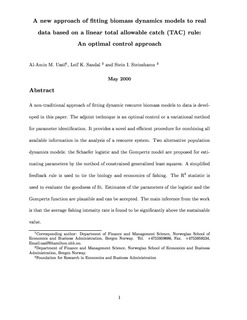| dc.contributor.author | Ussif, Al-Amin M. | |
| dc.contributor.author | Sandal, Leif Kristoffer | |
| dc.contributor.author | Steinshamn, Stein Ivar | |
| dc.date.accessioned | 2006-07-14T07:57:14Z | |
| dc.date.available | 2006-07-14T07:57:14Z | |
| dc.date.issued | 2000-05 | |
| dc.identifier.issn | 1500-4066 | |
| dc.identifier.uri | http://hdl.handle.net/11250/163707 | |
| dc.description.abstract | A non-traditional approach of fitting dynamic resource biomass models to data is developed in this paper. The adjoint technique is an optimal control or a variational method for parameter identification. It provides a novel and efficient procedure for combining all available information in the analysis of a resource system. Two alternative population dynamics models: the Schaefer logistic and the Gompertz model are proposed for estimating parameters by the method of constrained generalized least squares. A simplified feedback rule is used to tie the biology and economics of fishing. The R2 statistic is used to evaluate the goodness of fit. Estimates of the parameters of the logistic and the Gompertz function are plausible and can be accepted. The main inference from the work is that the average fishing intensity rate is found to be significantly above the sustainable value. | en |
| dc.format.extent | 250123 bytes | |
| dc.format.mimetype | application/pdf | |
| dc.language.iso | eng | en |
| dc.publisher | Norwegian School of Economics and Business Administration. Department of Finance and Management Science | en |
| dc.relation.ispartofseries | Discussion paper | en |
| dc.relation.ispartofseries | 2000:7 | en |
| dc.title | A new approach of fitting biomass dynamics models to real data based on a linear total allowable catch (TAC) rule : an optimal control approach | en |
| dc.type | Working paper | en |
